Lakeland, FL Pollen and Allergy Report for Summer 2023
Pollen Allergy Trends in Lakeland, FL
When is pollen lowest in Lakeland, FL?

May
Lowest month total PPM
Avg. PPM
When is pollen highest in Lakeland, FL?

April
Highest month total PPM
Avg. PPM
How does pollen in Lakeland, FL compare to Florida?
Lakeland has a lower average PPM than the state of Florida.
Lakeland yearly avg PPM:
Florida yearly avg PPM:
How does pollen in Lakeland, FL compare to the USA?
Lakeland has a higher average PPM than the USA.
Lakeland yearly avg PPM:
USA yearly avg PPM:
Is pollen worse this year in Lakeland, FL?
Spring 2023 was better than spring 2022.
Spring 2023 PPM:
Spring 2022 PPM:
Average PPM in Lakeland, FL


Lakeland, FL Pollen and Allergy Breakdown by Month
Grass
When is grass pollen highest in Lakeland, FL?
April has the highest grass pollen in Lakeland, FL with an average PPM of
When is grass pollen lowest in Lakeland, FL?
December has the lowest grass pollen in Lakeland, FL with an average PPM of
Tree
When is tree pollen highest in Lakeland, FL?
March has the highest tree pollen in Lakeland, FL with an average PPM of
When is tree pollen lowest in Lakeland, FL?
July has the lowest tree pollen in Lakeland, FL with an average PPM of
Weed
When is weed pollen highest in Lakeland, FL?
June has the highest weed pollen in Lakeland, FL with an average PPM of
When is weed pollen lowest in Lakeland, FL?
February has the lowest weed pollen in Lakeland, FL with an average PPM of
Lakeland, FL Pollen Monthly Breakdown by Pollen Type

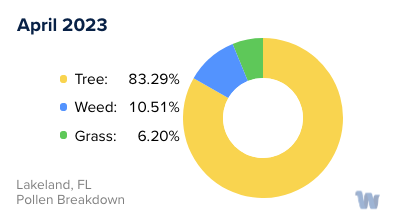

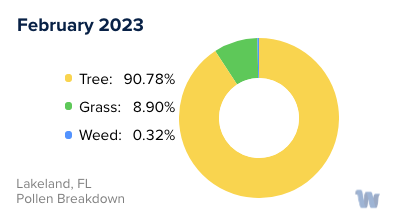



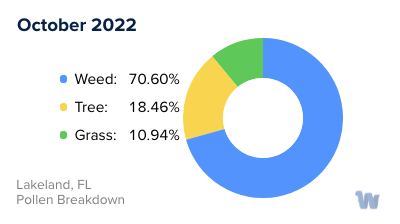
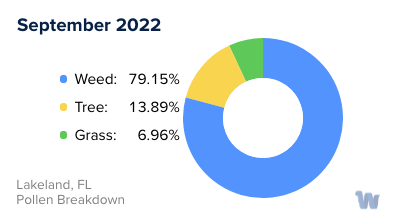


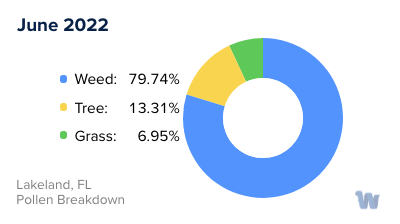
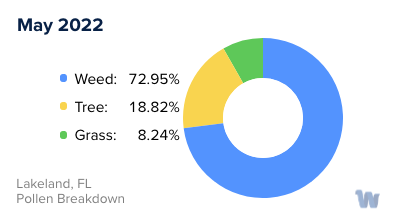
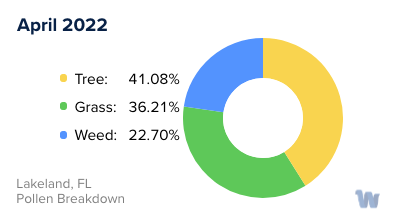


Pollen and Hay Fever in Lakeland, FL
In the sunshine city of Lakeland, Florida, pollen allergies, commonly known as hay fever, can be a significant concern for residents and visitors alike. The allergy season here tends to extend a bit longer than in other regions. Pollen, the tiny, airborne particles released by plants for reproduction, is the main culprit behind these allergies. The types of pollen affecting allergy sufferers in Lakeland vary by season, with different plants releasing their pollen at different times of the year.
In the spring, trees are typically the first and most prominent pollen producers. Some of the primary tree types contributing to pollen counts in this season include oak, bayberry, and hickory. The pollen from these trees can lead to medium to high levels of pollen in the air, especially during peak times, which usually occur in late March.
As the calendar turns to late spring and early summer, grass pollen becomes the primary concern. The grass pollen levels in Lakeland tend to be average compared to other regions. Nevertheless, the peak of the grass pollen season usually arrives in early May, potentially causing discomfort to those with pollen allergies.
The end of summer and the beginning of fall ushers in the season of weed pollen. Interestingly, Lakeland, as part of Florida's East Coast, could face high counts of weed pollen due to increased moisture and temperatures, conditions that are favorable for weed growth. The peak of the weed pollen season typically hits in August.
In conclusion, understanding the pollen seasons in Lakeland, Florida, is essential for those who experience pollen allergies. The fluctuating levels and types of pollen — from trees in the spring, grass in the early summer, and weeds in the late summer and early fall — demonstrate the dynamic nature of pollen allergies in this region. Awareness and preparedness, without a doubt, can go a long way toward navigating the pollen seasons in Lakeland, Florida.

